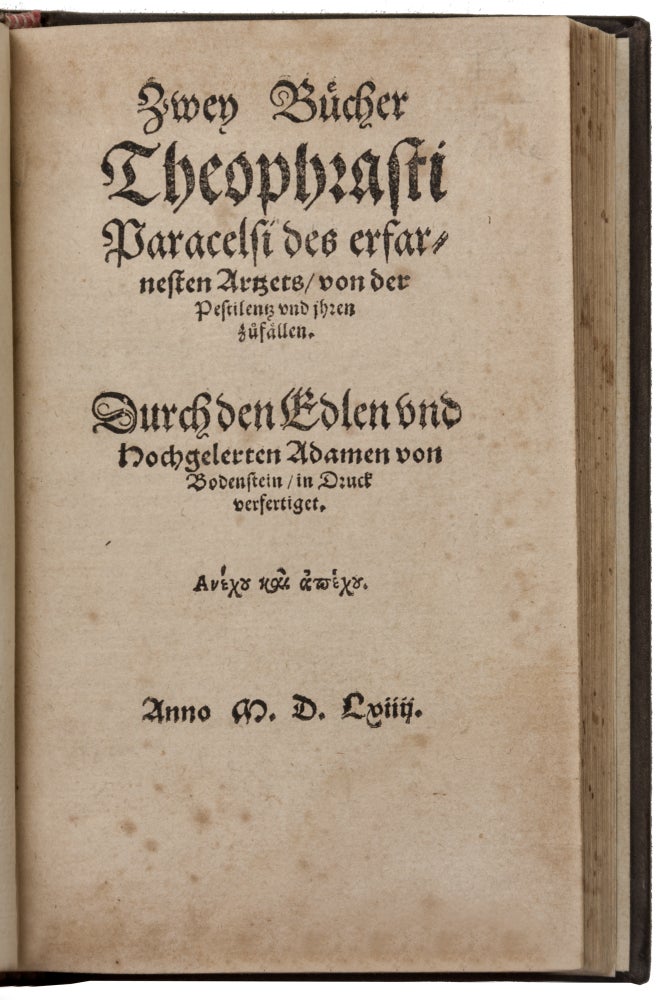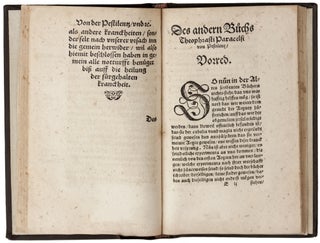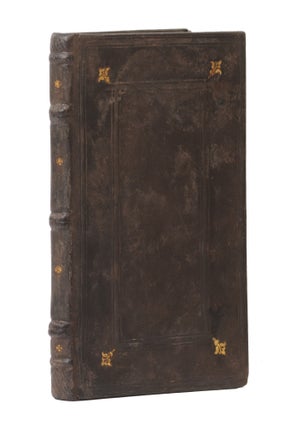Zwey Bücher … von der Pestilentz und ihren Zufällen.
8vo. (112) ff, pages [2] and [110-112] are blank. Bound in modern paneled calf, with gilt-stamped fleurons on front and back covers, raised bands. Generally good. The first edition of this plague treatise by Paracelsus (Theophrastus Bombastus von Hohenheim, 1493-1541), the “Luther of Medicine” and one of the key figures in the history of medicine. Written originally in Nördlingen in 1529-1530, it remained unpublished during Paracelsus’ lifetime and subsequently taken up and edited for publication by the Paracelsian scholar Adam von Bodenstein (1528-1577). The latter dedicated it to Johann Rudolph Stör von Störenberg, Abbot of Murbach and Luders. In addition to the study on pestilence, the text includes two short works by Paracelsus: “Vom Preservatiff durch den Schwebel” and “Von der Mummia.” In the primary tract, Paracelsus for the first time presents his complex theory on the origins of the plague which he believed were the result of astrological and corporeal events set in motion by human sins. “This anthropocentric view of an individual disease is in harmony with Paracelsus’ whole philosophy and indeed with Renaissance philosophy in general” [Pagel, p. 179]. Paracelsus also postulates the importance of the principle of sulphur (the corresponding agent of the planet Mars) in pestilence’s causation. He believed that sulphur, hidden in three minerals—antimony, arsenic, and marcasite—affected three corresponding organs: the groin, the axillae, and the ears. The chapters on causation are followed by sections on remedies. The doctor must cure the agent causing the disease rather than the symptoms of the disease, Paracelsus writes. Humoral pathology and its insistence on diet is of no use. “Paracelsus’ plague remedies include sulphur (spirit of vitriol, sulphur sublimate) and metals, also—for external treatment of boils—toads and decoctions of beetles (designed to remove the evil of magnetic attraction), but herbs and drugs as prescribed by Ficino and Agrippa are greatly amplified and still appear in a prominent place” [Pagel, pp. 180-181, n. 151]. The editor of this volume, Adam von Bodenstein was one of the key figures in the revival of Paracelsian ideas in the German lands in the middle of the sixteenth century. A son of a radical reformer, he believed in transmutation of metals into gold and played a key role in the publication of over 80 works by Paracelsus. For his Paracelsianism, he was excluded from the faculty and council of Basel University. OCLC records US copies at NYAM, NLM, Wash. U and UMn. *Karl Sudhoff, Bibliographia Paracelsica (Berlin, 1894), 60; Walter Pagel, Paracelsus: An Introduction to Philosophical Medicine in the Era of the Renaissance (Boston, 1982, 2nd, revised edition); Georgiana D. Hedesan, “Alchemy, Potency, Imagination Paracelsus’s Theories of Poison,” in John Arrizabalaga, Ole Peter Grell, Andrew Cunningham, eds., It All Depends on the Dose: Poisons and Medicines in European History. The History of Medicine in Context Series (New York, 2018), pp. 81-102; Peter J. Forshaw, “‘Paradoxes, Absurdities, and Madness:’ Conflict over Alchemy, Magic and Medicine in the Works of Andreas Libavius and Heinrich Khunrath,” Early Science and Medicine, vol. 13, no. 1 (2008), pp. 53-81.
Price: $6,500.00



